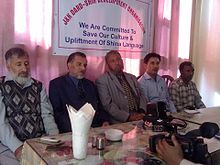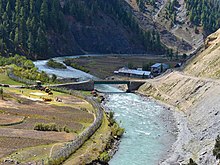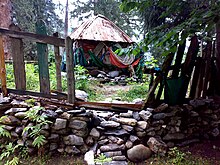用 Himalayas Gurez, 去 google 搜索,資訊照片頗多
***
https://en.wikipedia.org/wiki/Gurez
可惜少嚴冬照片.....




Gurez Guráai Gurais | |
|---|---|
Tehsil | |
 View of Habba Khatoon in Gurez | |
| Coordinates: 34.6333°N 74.8333°E | |
| Country | India |
| Union Territory | Jammu and Kashmir |
| District | Bandipora |
| Government | |
| • Vidhan Sabha Constituency | Gurez |
| • MLA | Vacant[2] |
| • Sub-Divisional Magistrate | Dr. Mudasir Ahmad Wani, JKAS[3] |
| Elevation | 2,580 m (8,460 ft) |
| Population (2011) | |
| • Total | 37,992[1] |
| Demographics | |
| • Literacy[1] | 59.17% |
| • Sex ratio[1] | 653 ♀/ 1000 ♂ |
| Languages | |
| • Official | Kashmiri, Urdu, Hindi, Dogri, English[4][5] |
| • Spoken | Shina, Kashmiri |
| Time zone | UTC+5:30 (IST) |
| PIN | 193503 |
| Vehicle registration | JK-15 |
| Website | bandipore |
Gurez, or Gurais[6] (Guráai in the local Shina language),[7] is a valley located in the high Himalayas, about 86 kilometres (53 mi) from Bandipore and 123 kilometres (76 mi) from Srinagar, to the north of the Kashmir valley. At about 2,400 metres (8,000 ft) above sea level, the valley is surrounded by snow-capped mountains. It has diverse fauna and wildlife including the Himalayan brown bear and the snow leopard. The Kishanganga River flows through the valley.[8]
The valley lies near the Line of Control, which separates it from the Astore and Neelum districts of Pakistan-administered Kashmir. Being situated very close to the Burzil Pass, which leads into Astore, the inhabitants are ethnic Dards/Shins. They speak the Shina language and have the same styles of dress and culture as their kinsmen in Pakistani-administered Gilgit-Baltistan.[9]
Dawar is the central township in the area. The population of the area is estimated to be about 30,000, and is scattered among fifteen villages. Tourism industry is emerging , hotels like Gurez knights, kaka Palace, woodvibes provide service to tourists.
Due to heavy snowfall (around 2 metres (7 ft)) and closure of Razdan Pass in winter, the valley remains cut off for six months of the year.[10]
History[edit]
Historically, Gurez was part of ancient Dardistan, stretching between Sharada Peeth in the west, Minimarg in the north, Drass in the east, and Bagtore in the south. The valley falls along the ancient Silk Route, which connected the Kashmir Valley with Gilgit, before continuing further to Kashgar. Archaeological surveys in valleys north of Gurez have uncovered hundreds of carved inscriptions in Kharoshthi, Brahmi, and Tibetan. In particular, the carvings provide insights into the origins of the Kashmiri people and the early history of Buddhism.
The ancient capital of the Dards, Dawar, is located in the Gurez Valley and is an important archaeological site. Other archaeological sites of importance in the valley include Kanzalwan, where the last council of Buddhism is believed to have been held and, further downstream, the ruins of the ancient Sharda University are preserved along the Kishenganga/Neelum River.
Prior to the partition of Kashmir, Gurez had been a destination for foreign tourists, including Franklin Delano Roosevelt, who is known to have visited some time before he became the US president.[11] During the colonial period, Gurez was often visited by trekkers. Nehru and Indira Gandhi, accompanied by Sheikh Abdullah, were among those who visited the area in the 1940s, fishing for trout at Naranag, one of the lakes in the mountains above the valley.[12]
Geography[edit]
While describing the Kishenganga Valley (Gurez), Walter R. Lawrence writes in his book The Valley of Kashmir,
Habba Khatoon[edit]


Gurez's most formidable peak is Habba Khatoon, around which legends abound and at one time, even a film starring Dimple Kapadia was planned.[15] This pyramid shaped peak was named after the Kashmiri poet Habba Khatoon. She was a beautiful and intelligent woman from Saffron village chandhara, and originally known as "Zoon" (which means Moon in English). She was the daughter of a peasant Abuddi Rather, who married her to an illiterate peasant boy named Habba. Zoon was ill-treated by her mother-in-law and husband, because she spent most of her time in poetry and singing. Dejected by her plight, she changed her name to Habba Khatoon.
The emperor of Kashmir, Yousuf Shah Chak, was enthralled by her beauty, intelligence and poetry. He arranged her divorce from Habba and married her. According to the story, Shah Chak was imprisoned by his rival King Akbar, Habba Khatoon used to wander near the peak that now bears her name to look for her lover. After her husband's death, she wandered the banks of river Jhelum in mourning. She died twenty years later by drowning into the jhelum and now her tomb is at Athwajan.[16] [17] Habba Khatoon Drama club was founded in 1976 by the poet Late Hajji Abdul Aziz Samoon (Retired Police Officer; SSP). The club played a pivotal role in safeguarding the cultural ethos and traditions of the Dard-Shin tribe. Hajji Abdul Aziz Samoon(KPS) was also Chairman of Jammu and Kashmir Dard-Shina Development Organization (JKDSDO), a body representing Dard community in the state JKDSDO [18] [19]
Economy[edit]

Energy[edit]
There is no central electricity in Gurez, although, as of 2009, a hydro-electric plant was constructed by the National Hydroelectric Power Corporation. It is unclear if any of the generated energy will be available to the valley itself.[20] India had initially planned to construct a 100-metre-high dam on the Kishenganga, which would have flooded the majority of the Gurez Valley and forced nearly all of its residents to relocate. But due to resistance by the Dard Shin and by Pakistan Government, which is constructing a dam downstream, the dam's height was reduced to 37 metres. Set for completion in 2016, the dam now diverts water from the Kishenganga towards Wular Lake in Bandipora district via a 20 kilometre concrete tunnel, and generates 330 Mega Watts electricity for the Indian States. Although construction of the dam has temporarily bring work and money into the area, the Dard Shin have expressed concern that around 130 families were forced to leave their homes and to relocate in the different districts of Jammu and Kashmir, and more than 300 hectares (740 acres) of land in the valley is submerged.[21]
Because of the lack of electricity, there is no significant industrial activity in the valley. The only electricity which is available comes from a few diesel generators which provide power to some parts of the area in summer for an hour at a time. The Indian government's relocation plans are unclear, and it has not yet committed to providing hydroelectricity to those who will remain in the valley.[22]
Fishery[edit]
Kishenganga River, with a length of 150 kilometres (93 mi), supports world-class trout with an average weight of 11 kilograms (24 lb). As of 2006, there were plans to develop the fishery potential of the area, making it a resource for the surrounding region.
Fish in the river include:[23]
- Brown trout (Salmo trutta fario)
- Rainbow trout (Salmo gairdneri)
Demographics[edit]
According to the 2011 census of India, Gurez Tehsil had a population of 37,992 people with 22,978 males and 15,014 females. The number of Scheduled Castes and Scheduled Tribes numbered 104 and 31,094 respectively. Most of the people in Gurez speak Kashmiri and Shina.[1]
Religion[edit]


Gurez is majority Sunni Muslim. Before the arrival of Mir Sayyid Ali Hamadani, the region was predominantly Hindu. Hamadani visited the Kashmir valley three times, accompanied by about seven hundred preachers, known as "Sadaats". Of these seven hundred people, seven settled in Gurez and included Baba Abdur Razaq Shah and Baba Dervaish whose shrines are located near the hamlet of Fakirpora. The names of the other saints are unknown, although they also have shrines, located at Chorwan, Bagtore, Dangital Tulail across the Kishan Ganga River, and at Kamri across the border near Dood-Gagi village in Pakistan administered Jammu and Kashmir.[25]
Islam is the largest religion in Gurez, followed by 84% of the people. Hinduism is the second-largest religion with 14.24% adherents. Sikhism and Christianity form 1.1% and 0.3% of the population respectively.[24]
Peer Baba[edit]



沒有留言:
張貼留言